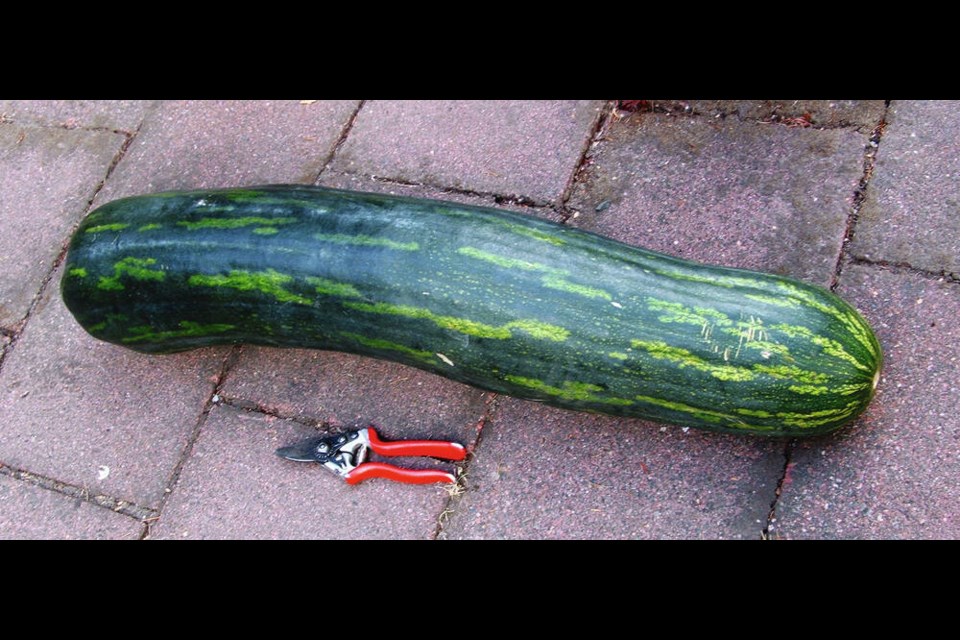I made my first cut into Lunga di Napoli on the afternoon of Dec. 23.
I’d cut the almost metre-long squash from its vine in the third week of October, staggered into the house with it, cleaned and then “cured” it for a week in a warm spot before hoisting the 15-kilo squash onto the broad trays of my plant light stand for storage in the cool temperatures of the front door hallway.
I had my sights on Christmas dinner, which would include steamed squash and a faux pumpkin pie made with the squash.
After ordering the seeds early last year, I did some research on Lunga di Napoli and discovered that is has been, over centuries, a popular, multi-use staple food in southern Italy.
I found the squash to be almost all flesh, with a very small centre cavity that disappeared toward the stem end. There were few seeds at the far, blossom end, which probably accounts for the limited availability of this variety in seed catalogues. My original source for the seeds no longer lists Lunga di Napoli, but another, American company called Truelove Seeds does have it. Their website has excellent photos of the squash. They ship seeds to home gardeners on Canada.
Using squash. Over the holidays I cut a slab away every few days, intending to use the flesh in as many ways as possible.
Lunga di Napoli is an easy slicer, unlike some winter squash types I’ve grown. You may have encountered them — squash that take a hacksaw and the strength of Hercules to cut through the hard skin.
The processing of my outsized squash went quickly. The skin sliced off each slab, I cut most of the flesh into large cubes for steaming. With the cooked flesh I made two pies and froze a half-dozen containers to use later as a dinner vegetable and for more pies.
As I prepared the rich orange flesh for cooking, I ate a fair amount raw. The aroma is pleasant, like cantaloupe, the texture crisp and tender, the taste sweet.
I grated the nutritious flesh into green leafy salads. I made a ginger and garlic flavoured squash soup.
The pies, spiced with extra cinnamon, cloves and grated ginger root and flavoured with a dollop of Baileys Irish Cream, were delicious, but what surprised me the most was how tasty and satisfying was the squash simply steamed and served with butter, salt and pepper.
Most winter squash types can be used in all these ways, except perhaps for eating the flesh raw.
I’ve grown many different winter squashes over the years. Lunga di Napoli is the most unusual and versatile, easy to process and delicious of them all.
Winter comfort food. Whenever overnight visitors are expected, I prepare a few dishes ahead of time for quick lunches and snacks.
For this I often turn to variations on a basic Italian recipe for Torta Salata di Zucchine — a tart made in summer with zucchini slices, onion, eggs and cream. Here, we would call it a quiche.
In recent years I’ve made the quiche year round, using whatever vegetables I have on hand. The mixed vegetable quiche I made for an early December pot-luck gathering was well received, and I made another just before Christmas.
At the time I had my own stored onions and garlic. Carrots awaited pulling from the garden. I usually include kale, but the garden’s kale was frozen during the pre-Christmas cold spell. There were garden peas in the freezer, mushrooms and a piece of cabbage in the fridge.
I began with sautéing a chopped onion and a few minced garlic cloves in butter, and then adding chopped cabbage, grated carrot and sliced mushrooms. After the vegetables cooked on low heat in a covered wok for around 15 minutes, I took the wok off the heat and added frozen peas and small cubes of cheddar cheese, stirring them in.
When the mixture had cooled a little, I added a little salt and a pre-blended mix of four eggs and one cup cream. The filling is baked in a pie shell at 375 F for 25 minutes or until golden on top. For the Christmas quiche I decorated the top, before baking, with red pepper strips and sliced black olives. The quiche is good hot or cold.



